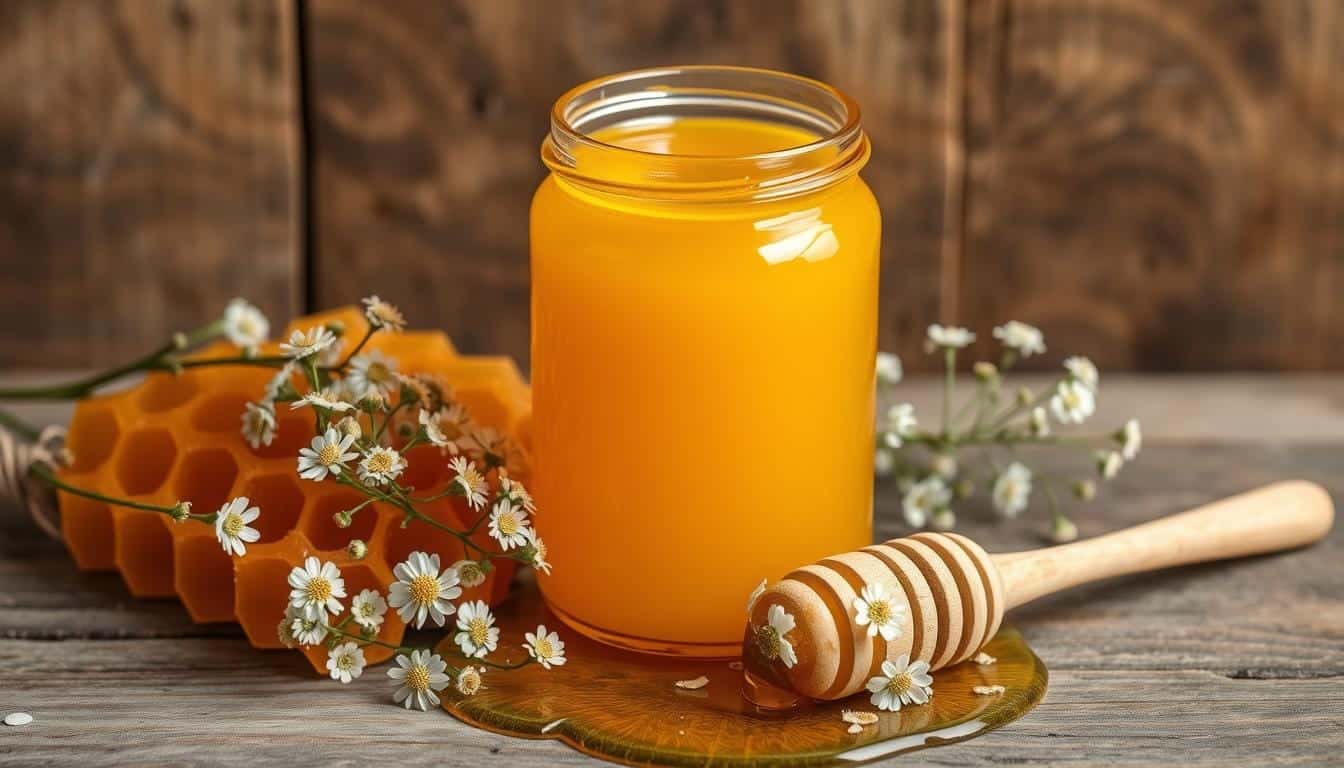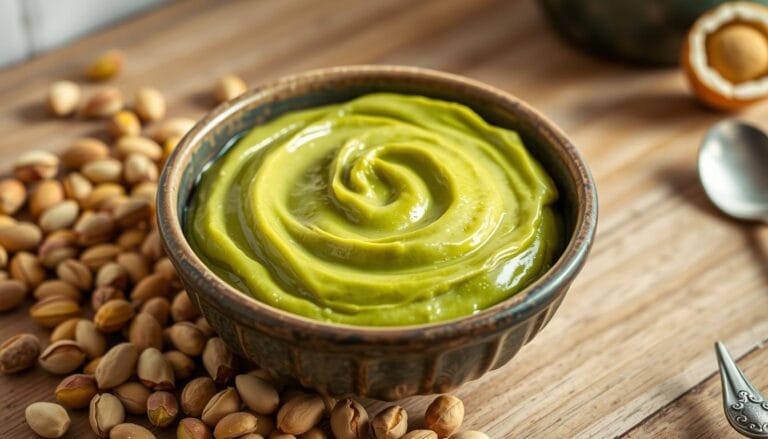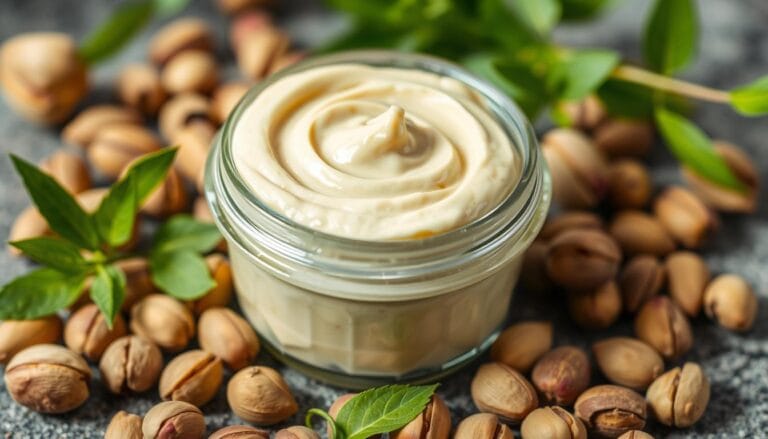How to make creamed honey at home
Here’s the updated text with the requested phrase inserted:
Imagine holding a jar of silky, spreadable honey that melts on your tongue, leaving behind a lingering sweetness. This isn’t just a dream – it’s the reality of making creamed honey at home. As a passionate home cook and beekeeper, I’ve discovered the joy of transforming raw honey into a delectable, velvety treat. How to make creamed honey is not just a question, but a delightful process that unlocks a world of culinary possibilities. Join me on this journey as we explore the art of creating your own creamed honey, right in your own kitchen.
Table of Contents
Key Takeaways
- Discover the science behind honey crystallization and how to harness it to create creamed honey.
- Learn the essential equipment and ingredients needed to make creamed honey at home.
- Understand the importance of selecting the right raw honey for successful crystallization.
- Explore step-by-step instructions for the creaming process, including temperature control and timing.
- Discover creative ways to use your homemade creamed honey in cooking, baking, and beyond.
Understanding What Creamed Honey Is and Its Benefits
Creamed honey, also known as granulated honey or spreadable honey, is a special type of honey. It’s made by changing liquid honey into a smooth, creamy, and spreadable form. This is done through a controlled crystallization process that changes the honey’s molecular structure.
The Science Behind Honey Crystallization
Honey has a mix of fructose and glucose. Over time, the glucose can start to crystallize, forming small crystals. This is called honey crystallization. Creamed honey uses this natural process but manages it to get a smooth and creamy result.
Why Choose Creamed Honey Over Regular Honey
- Creamed honey has a richer, creamier texture that’s easier to spread. It’s great for topping toast or sweetening baked goods.
- The controlled crystallization process helps keep the honey’s natural flavors and aroma. This makes it more enjoyable to taste.
- Creamed honey is less likely to drip or spill. This makes it more convenient for use in the kitchen or on the table.
Nutritional Benefits of Creamed Honey
Like regular honey, creamed honey keeps the same nutrients and antioxidants. Creamed honey offers several benefits:
- It’s a good source of carbohydrates, including fructose and glucose. These can give a natural energy boost.
- It contains trace amounts of vitamins and minerals like vitamin C, vitamin B6, iron, and calcium.
- It may have antimicrobial properties. It can help soothe sore throats or be used for minor wound healing.
“Creamed honey is a delightful and versatile form of this natural sweetener that offers a unique texture and flavor profile.”
Essential Equipment and Ingredients for Making Creamed Honey
Making creamed honey at home is easy with the right tools and ingredients. Whether you’re new to beekeeping or love honey, you can make creamed honey at home. Let’s look at what you need to turn raw honey granulation into a smooth spread.
Essential Equipment
- Stainless steel or food-grade plastic containers: These durable vessels will hold your honey during the creaming process.
- Immersion blender or stand mixer: Agitating the honey is crucial for achieving the desired creamy texture.
- Thermometer: Monitoring the temperature throughout the process ensures optimal crystallization.
- Spatula or spoon: Used for scraping and transferring the creamed honey into storage containers.
Selecting the Right Honey
The key to great creamed honey is using high-quality raw honey. Choose local, unprocessed honey with lots of natural pollen and enzymes. Clover, wildflower, and buckwheat honeys are best for creamed honey because they crystallize well.
| Honey Variety | Crystallization Rate | Flavor Profile |
|---|---|---|
| Clover | Moderate | Mild, sweet |
| Wildflower | Fast | Complex, floral |
| Buckwheat | Slow | Robust, earthy |
With the right tools and raw honey, you can make your own creamed honey at home.
Selecting the Right Raw Honey for Crystallization
Choosing the right raw honey is key for making creamed honey at home. Not all honeys are good for creating that smooth, creamy texture. To get perfect homemade creamed honey, pick the right honey from the start.
Best Honey Varieties for Creaming
Honeys with high glucose content are best for creaming. Clover, wildflower, and alfalfa honeys are top choices. They crystallize easily and become smooth when creamed.
Quality Indicators to Look For
- Choose raw honey that’s minimally processed and unfiltered. It has more minerals and pollen, helping with raw honey granulation.
- Avoid pasteurized or ultra-filtered honeys. They lack the natural ingredients needed for honey crystallization.
- Opt for honey with a grainy or creamy texture. It shows it’s starting to crystallize naturally.
Temperature Considerations for Raw Honey
The honey’s temperature affects creaming. It should be around 70°F (21°C) before starting. Colder honey may resist crystallization, while warmer honey can become too coarse.
By picking the right raw honey and considering its temperature, you’ll make delicious homemade creamed honey. It will perfectly capture the natural sweetness and texture of honey.
How to Make Creamed Honey: Step-by-Step Process
Want to enjoy the smooth, creamy texture of homemade creamed honey? Making it at home is easy and fun. You can tailor the flavor and texture to your liking. Here’s a simple guide to making your own creamed honey.
Start with high-quality raw honey as your base. Raw honey is key because it has the enzymes and proteins needed for crystallization. After picking your honey, the steps are straightforward:
- In a clean, sterilized bowl or container, mix equal parts raw honey and creamed honey (seed honey). The creamed honey starts the crystallization process.
- Use a clean spoon or spatula to mix the honeys gently. Avoid adding too much air to keep the texture right.
- Cover the bowl and keep it in a cool, dark spot like a pantry or fridge. Keep the temperature between 55°F and 60°F (12.8°C to 15.6°C) for best results.
- Let the mixture sit for 24 to 48 hours. This lets it become creamy and spreadable. The time needed can vary based on the honey type and temperature.
When your creamed honey is just right, move it to jars or airtight containers. Don’t forget to label them with the date and what’s inside.
Homemade creamed honey is great because you can try different honeys and textures. Enjoy the fruits of your labor!
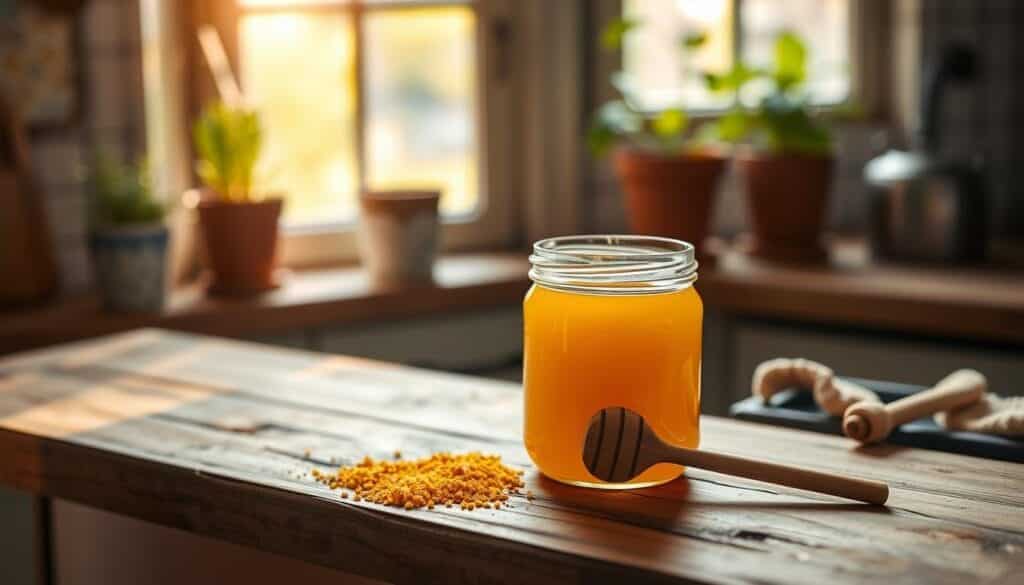
Temperature Control and Crystallization Timing
To make perfect creamed honey, you need to control the temperature well. Knowing how honey crystallizes is key. The temperature at each step affects the honey’s texture and consistency.
Optimal Temperature Ranges
For the best results, follow these temperature guidelines:
- Liquefying raw honey: 95°F to 104°F (35°C to 40°C)
- Cooling and seeding: 82°F to 86°F (28°C to 30°C)
- Creaming and stirring: 68°F to 75°F (20°C to 24°C)
Managing Crystallization Speed
Controlling how fast honey crystallizes is important. A slower process makes the honey creamier. To control the speed:
- Start with a lower temperature (68°F to 75°F/20°C to 24°C) for a slower, more gradual crystallization.
- Avoid sudden temperature drops, which can lead to rapid, uneven crystallization and a grainy texture.
- Monitor the process closely and make temperature adjustments as needed to maintain the desired pace of crystallization.
Common Temperature-Related Issues
Keeping the right temperature is key. Deviations can cause problems like:
- Overcrystallization: Excessive cooling can cause the honey to crystallize too quickly, resulting in a hard, gritty texture.
- Undercrystallization: Inadequate cooling can prevent proper crystallization, leaving the honey thin and runny.
- Fermentation: Storing the creamed honey at temperatures above 75°F (24°C) can lead to fermentation, rendering the honey unfit for consumption.
By watching and adjusting the temperature during the honey crystallization process, you can get a smooth, creamy, and consistent texture in your homemade creamed honey.
Storage and Preservation Methods
Keeping your homemade crystallized honey butter fresh is key to enjoying it for a long time. Whether you have a small batch or want to share, the right storage helps. It keeps your spreadable honey creamy and delicious.
Ideal Storage Containers
- Choose airtight glass or food-grade plastic containers to keep it fresh.
- Stay away from metal containers to avoid flavor changes.
- Wide-mouth jars make it easy to scoop out the honey.
Storage Conditions
- Store it at room temperature, away from sunlight and heat.
- Keep the temperature between 50°F and 70°F to prevent hardening.
- If it starts to harden, warm the container in a water bath to soften it.
Shelf Life and Freshness
Your homemade crystallized honey butter can last up to a year if stored right. Watch for changes in texture and color. If it smells bad or looks off, it’s time to make a new batch.
| Storage Condition | Shelf Life |
|---|---|
| Room temperature (50°F-70°F) | Up to 1 year |
| Refrigerator (40°F-45°F) | Up to 2 years |
| Freezer (0°F or below) | Indefinite |
By following these tips, your homemade spreadable honey stays fresh and tasty for months. With proper care, it becomes a valuable addition to your kitchen.
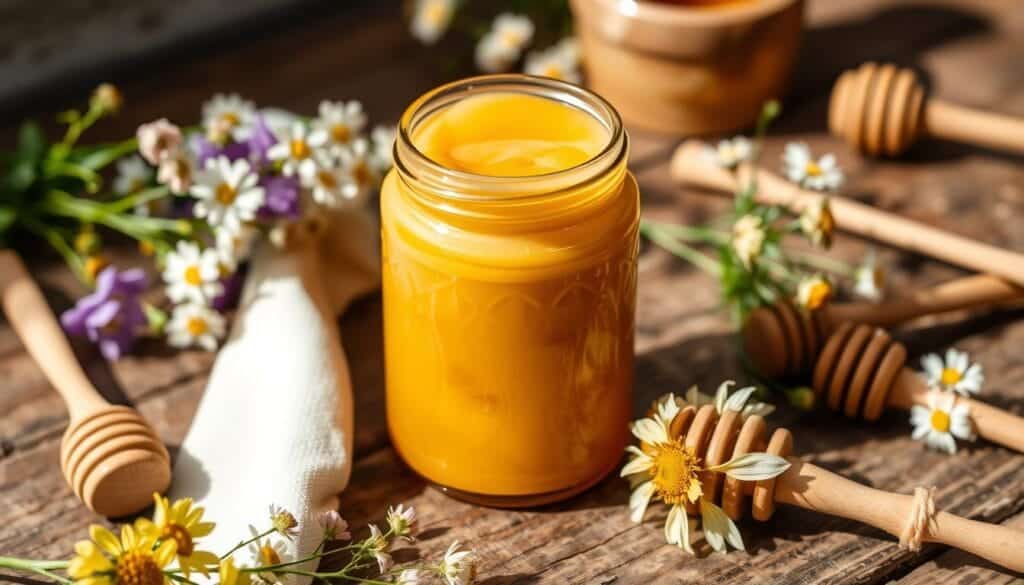
Troubleshooting Common Issues During the Creaming Process
Making creamed honey at home can be rewarding but comes with challenges. You might face a few common problems. But don’t worry, with the right knowledge, you can solve these issues and get the smooth texture you want.
Preventing Fermentation
Fermentation is a big worry when making creamed honey. It happens when the honey is too moist or the environment is too warm. To avoid this, make sure your honey’s moisture is below 18%. Use a refractometer to check and adjust as needed. Also, keep the area cool and dry while you work.
Fixing Texture Problems
If your creamed honey feels too soft or gritty, don’t worry. You can fix it by changing the seed crystal amount or the temperature. Adding more honey crystallization can make it firmer. If it’s too coarse, warm it a bit, then re-seed it with a smaller amount of creamed honey.
Addressing Crystallization Issues
Crystallization in honey is natural but can be a problem if it happens too fast or unevenly. To fix this, keep the temperature cool and consistent. Be patient, as slow crystallization leads to a smooth texture.
Remember, solving problems is part of the fun in making honey. With some trial and error, you’ll soon make delicious creamed honey for your pantry.
Creative Ways to Use Your Homemade Creamed Honey
Boost your cooking skills with homemade whipped honey and spun honey. These creamy honeys bring a new twist to traditional honey. They can be used in many recipes and dishes.
Begin your day with a sweet touch by drizzling creamed honey on yogurt or oatmeal. It makes breakfast feel luxurious. For a quick snack, try it with fresh fruit or on warm toast.
Get creative in the kitchen with creamed honey in baked goods. Add it to muffin or cookie batters for sweetness. Or, use it as a glaze for cakes and pastries. The options are endless!
Enhance your drinks with creamed honey. Mix it into tea or coffee for a unique flavor. Or, sweeten lemonade or iced tea with it. For a special treat, add it to cocktails or milkshakes.
When giving or serving creamed honey, think outside the box. Put it in decorative jars or honeypots. Pair it with artisanal bread, cheese, or nuts for a beautiful gift.
Explore the endless uses of homemade creamed honey. Enjoy its creamy texture and versatile taste. It will make your meals special and impress your friends.
Tips for Achieving Different Textures and Flavors
Creating your own creamed honey is more than just a recipe. You can make it smooth or chunky, depending on what you like. These tips will help you make your honey just right.
Infusing with Natural Flavorings
Make your creamed honey recipe special by adding natural flavors. Try using dried spices, citrus zest, or vanilla beans. Just mix them gently into your honey, adjusting the amount to taste.
Incorporating Fruit Purees
Want a fruity twist? Add some fruit puree to your creamed honey. Berries, bananas, pumpkin, or apple butter can add a creamy texture and flavor.
Adjusting Crystallization Techniques
The texture of your honey depends on how you crystallize it. Changing the temperature, how much you stir, and for how long can affect the crystals. Slower crystallization makes it smoother, while faster makes it chunkier.
| Texture | Crystallization Technique |
|---|---|
| Silky Smooth | Slow, gentle crystallization at cooler temperatures |
| Creamy and Spreadable | Moderate crystallization at moderate temperatures |
| Chunky and Textured | Rapid crystallization at warmer temperatures |
Try these methods to find your ideal creamed honey recipe and spreadable honey texture.
Conclusion
Congratulations on learning how to make creamed honey at home! You now understand the science behind honey crystallization and the benefits of creamed honey. You also know how to make it yourself.
Now, you can enjoy creamed honey’s smooth texture and rich flavor. Use it on toast, in baked goods, or on a charcuterie board. Homemade creamed honey is incredibly versatile.
Keep exploring creamed honey and try new things. Use different honey types and experiment with temperatures and uses. Making creamed honey is a journey of learning and creativity. Share your homemade honey with others to inspire them to try it too.
FAQ
What is creamed honey?
Creamed honey, also known as whipped honey, is a smooth, creamy honey spread. It’s different from regular honey because it’s spreadable. This makes it easy to use in various ways.
What are the benefits of making creamed honey at home?
Making creamed honey at home is rewarding. You can control the texture and flavor. Plus, it’s often cheaper than store-bought and uses high-quality honey.
How does the honey crystallization process work?
Honey crystallizes naturally, creating a smooth texture. Glucose molecules in the honey form tiny crystals. This makes the honey spreadable.
What are the differences between creamed honey and regular honey?
Creamed honey is smooth and spreadable. Regular honey is more liquid. Creamed honey is better for recipes and toppings.
What are the nutritional benefits of creamed honey?
Creamed honey has the same nutrients as regular honey. It also keeps more natural enzymes and nutrients due to its making process.
What equipment and ingredients do I need to make creamed honey at home?
You need raw honey, a bowl, and a mixer. The honey type and mixing time affect the texture.
How do I choose the right raw honey for creaming?
Choose honey that crystallizes easily, like clover or wildflower. It should be fresh and of high quality.
What is the step-by-step process for making creamed honey?
First, pick the right honey. Then, warm it and mix until creamy. Put it in a container and let it set.
How do I control the temperature and timing of the creaming process?
Keep the temperature between 55°F and 80°F. Mixing too fast or wrong can mess up the texture. Monitor the temperature and adjust as needed.
How should I store and preserve my homemade creamed honey?
Store it in an airtight container in a cool, dark place. This way, it can last several months or up to a year.
What are some common issues that can arise when making creamed honey, and how do I troubleshoot them?
Issues like fermentation or texture problems can happen. To fix these, ensure cleanliness and adjust mixing. Temperature control helps with crystallization.
How can I use my homemade creamed honey?
Use it on toast, in baking, or as a topping. Its creamy texture is perfect for many uses. Get creative and enjoy it daily.
How can I customize the texture and flavors of my creamed honey?
Mix it differently for different textures. Add spices or herbs for unique flavors. Experiment to find your favorite.
Did you Tray Our recipe?
How can I use my homemade creamed honey
Creamed honey, also known as whipped honey, is a smooth, creamy honey spread. It’s different from regular honey because it’s spreadable. This makes it easy to use in various ways.

